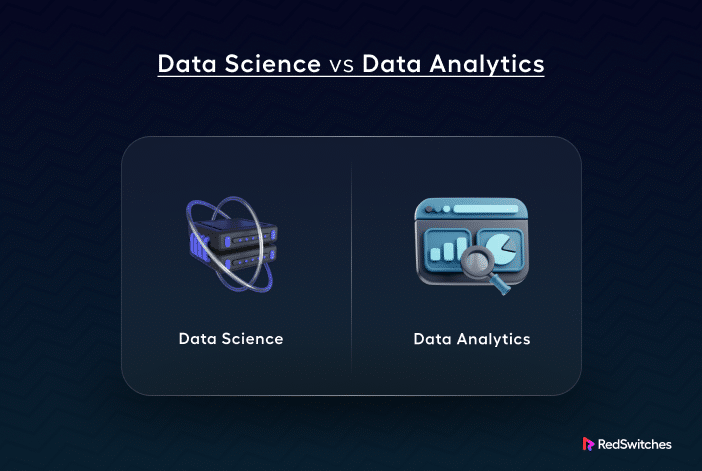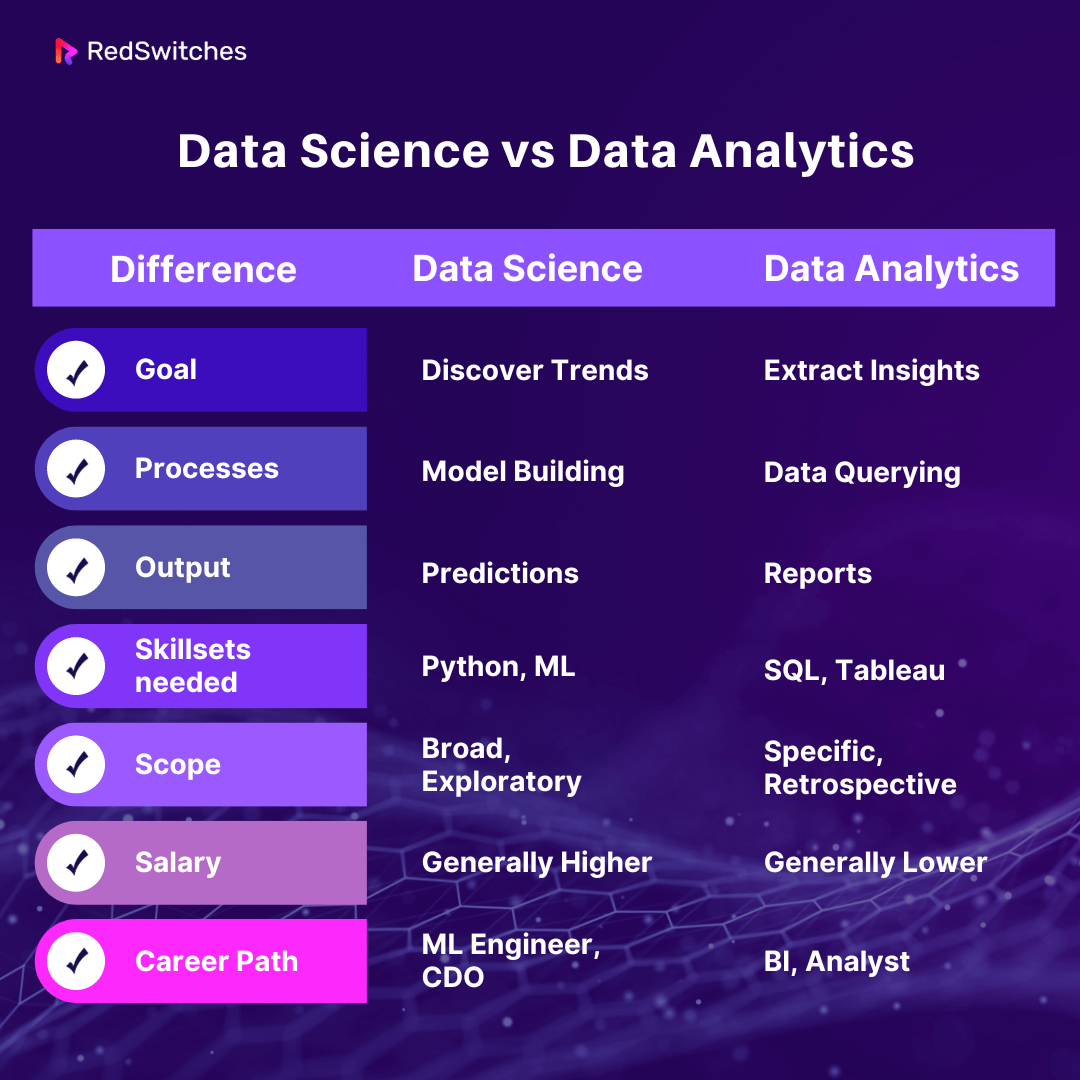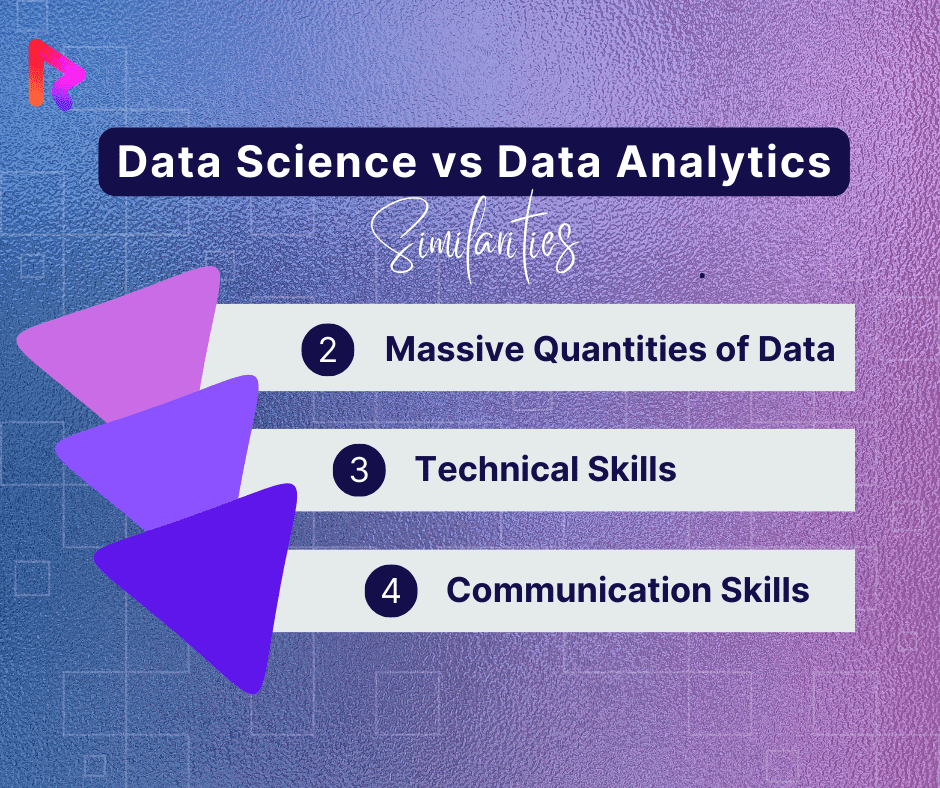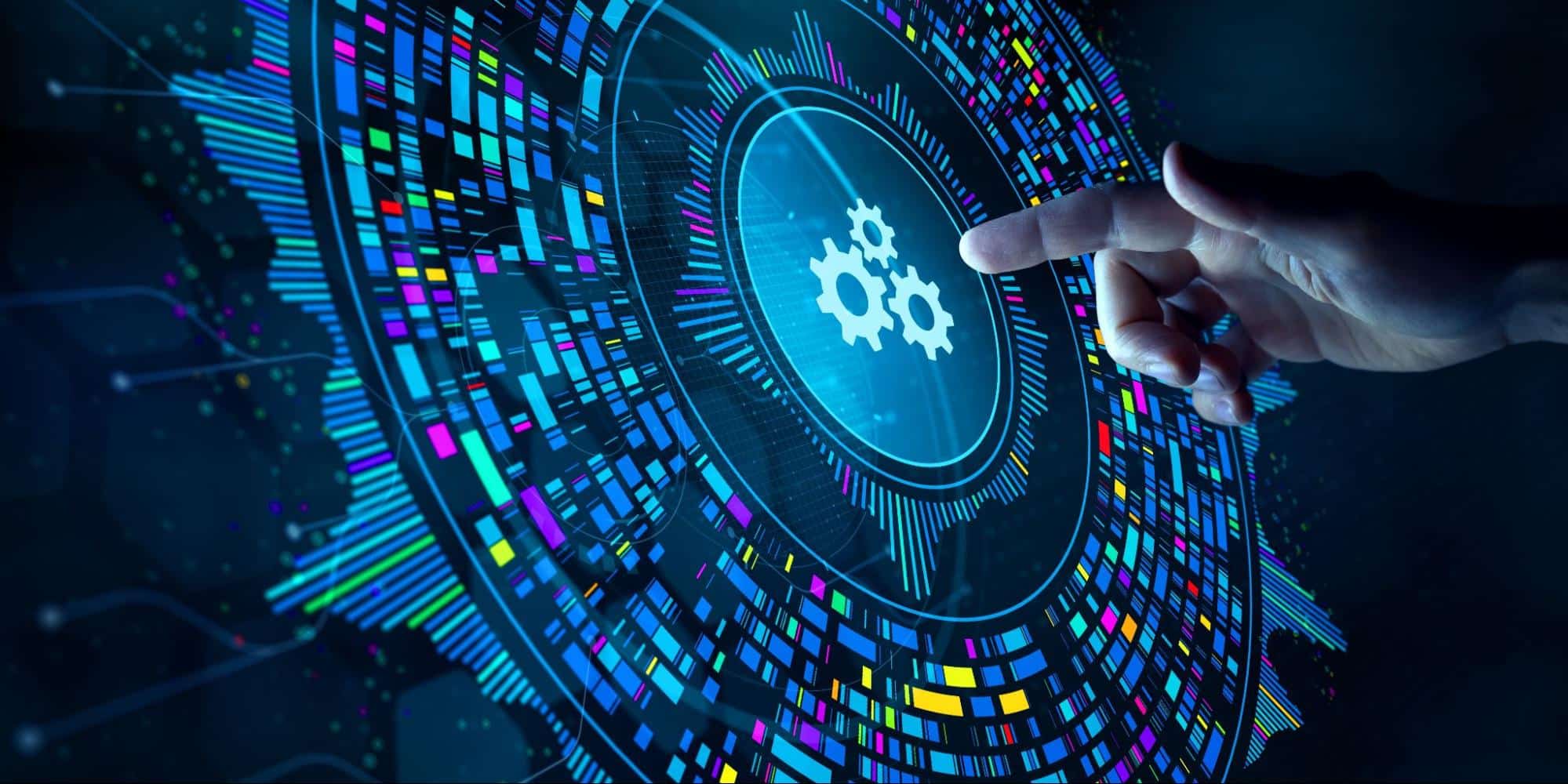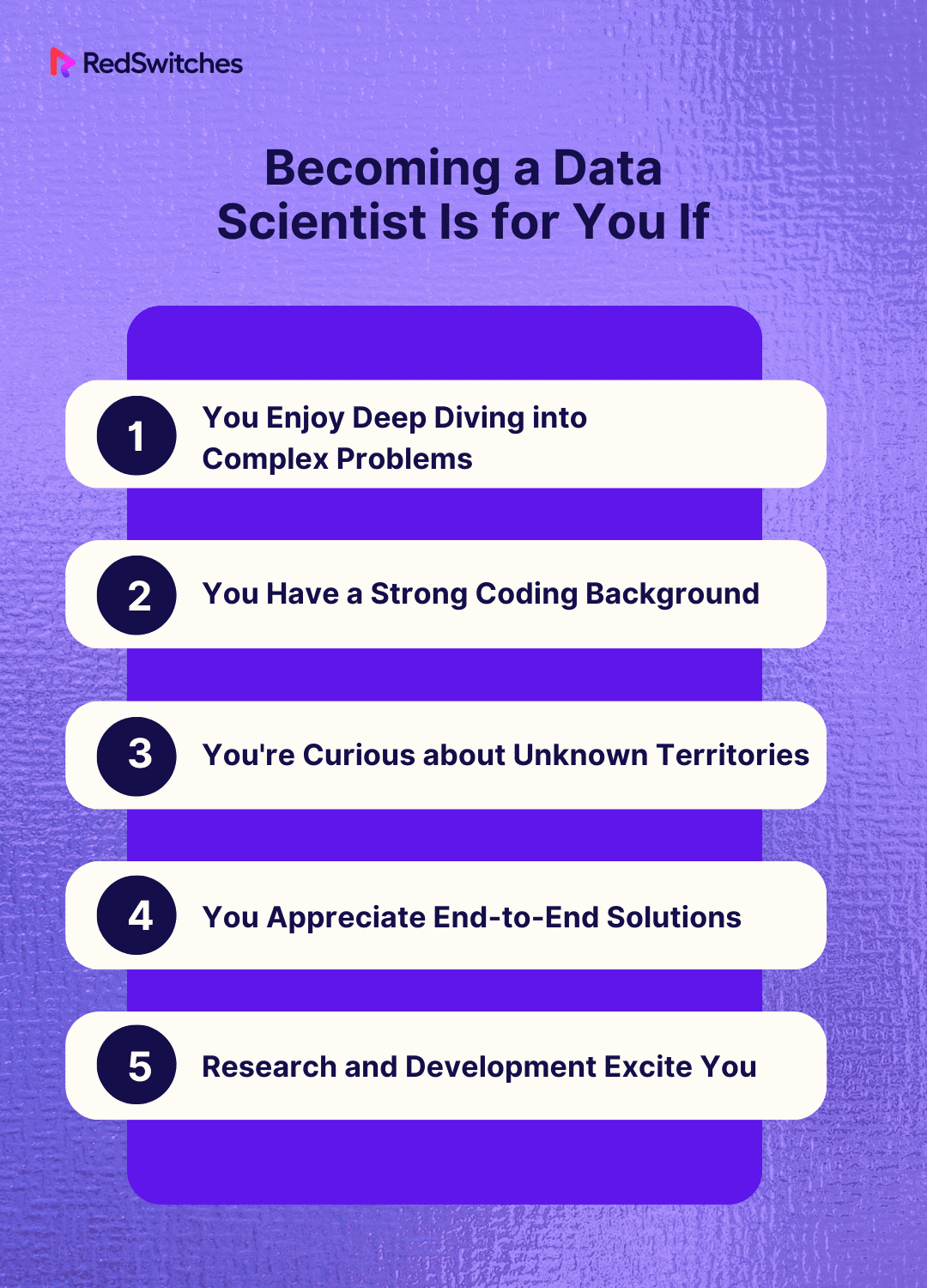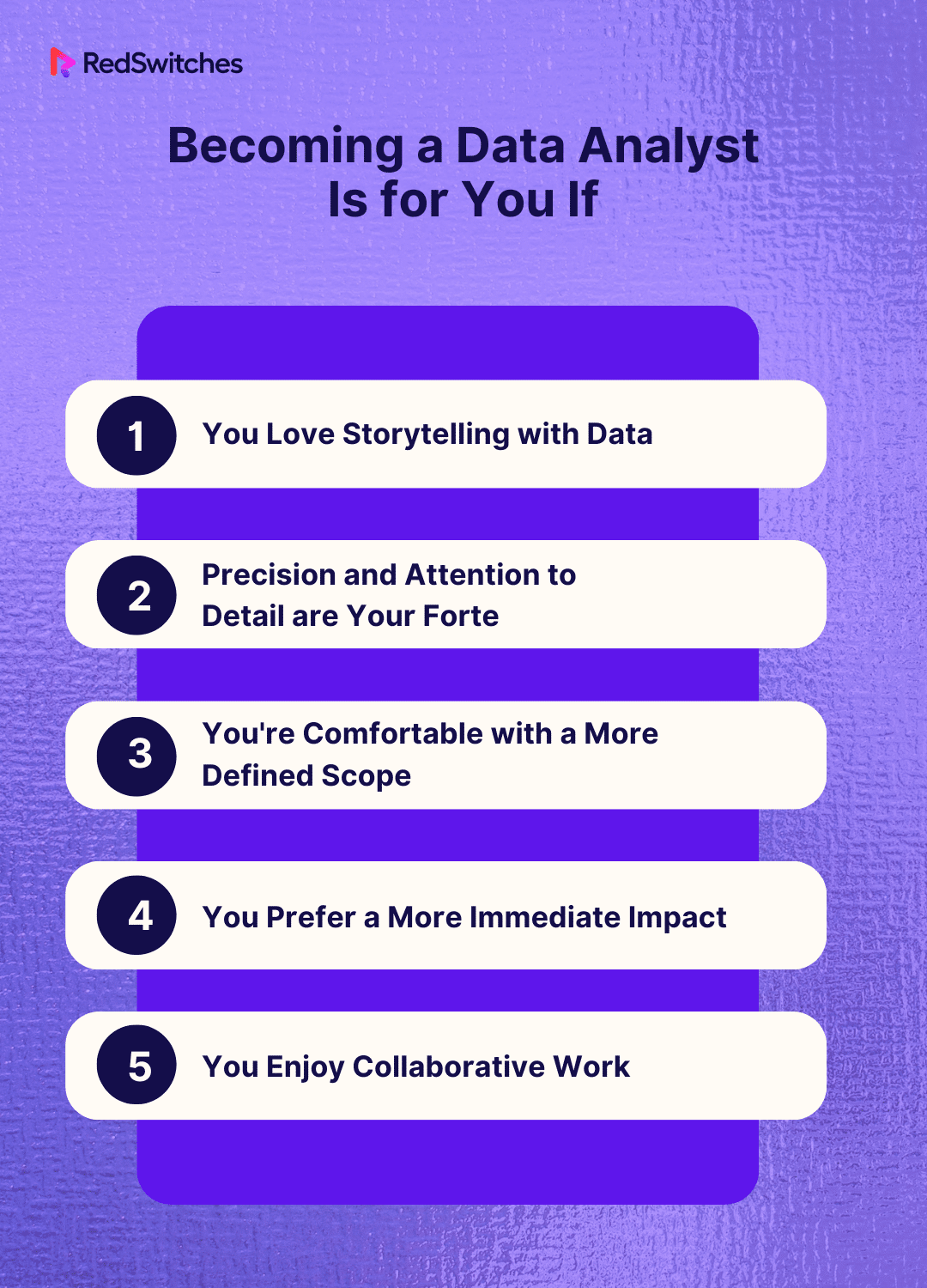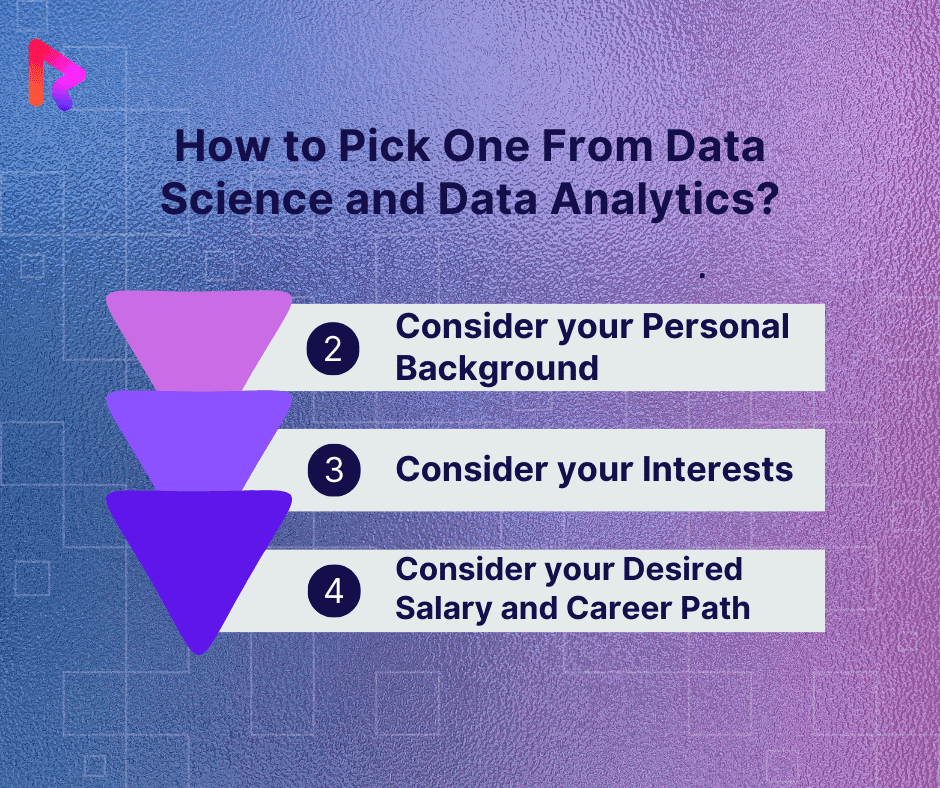In today’s data-driven world, terms like ‘Data Science’ and ‘Data Analytics’ are used interchangeably.
Global advanced analytics and data science software market share shows that MATLAB led the global advanced analytics and data science industry in 2021 with a market share of 13.5%, followed by HubSpot Analytics and Alteryx, which accounted for 9.21% and 9.92% of the market share.
With their fast-growing market share, one needs to understand the difference between data science vs data analytics to evaluate the best path for them. Although both fields circulate data, they cater to varying aspects of the data process.
This blog will explore the difference between data science and data analytics. We will discuss the disciplines’ roles, skills, and applications, enabling you to choose the right path for your career aspirations or project needs.
Table of Contents
- What Is Data Science?
- What Is Data Analytics?
- Data Science vs Data Analytics: Key Differences
- Data Science vs Data Analytics: Similarities Between the Two
- Which Is The Right Pick For You: Data Science or Data Analytics?
- Data Science vs Data Analytics: Real-Life Examples
- How to Pick One From Data Science and Data Analytics?
- Conclusion – Data Science vs Data Analytics
- FAQs
What Is Data Science?
Data Science is a broad field encompassing several techniques to handle, analyze, and visualize data. It’s a multidisciplinary area, blending statistics, computer science, and mathematics to interpret extensive and complex data.
A data scientist’s primary goal is to extract meaningful insights from extensive, messy, unstructured data and use the knowledge to solve real-world issues. Their job can comprise several tasks, including predictive modeling and machine learning, aiming to forecast future trends and behaviors.
What Is Data Analytics?
Data Analytics focuses more on processing and performing statistical analysis of datasets. The primary goal of data analytics is to collect actionable insights.
Data analysts examine large datasets to identify trends, develop charts, and create visual presentations to help businesses make more strategic decisions. The insights from data analytics are then used to recommend action, guiding a business to take specific steps to achieve desired outcomes.
Now that we’ve discussed the definitions of data science and data analytics, let’s explore the differences between data science and data analysis.
Data Science vs Data Analytics: Key Differences
Below are the key differences between data science vs data analytics:
Goal
Below is a comparison of the difference between data science and data analysis in terms of goal:
Data Science
At its core, data science is an interdisciplinary field that uses various techniques, algorithms, and systems to receive knowledge and insights from structured and unstructured data.
The primary goal of data science is to discover new phenomena or insights without necessarily having a specific question in mind. It focuses on exploration, pattern recognition, and deriving a holistic understanding of the data universe.
Data Analytics
Data analytics is more about processing and analyzing large data sets to answer specific questions. It is used to discover actionable insights and assist in decision-making. The main objective of data analytics is to find actionable recommendations, thus facilitating businesses in making informed choices.
Processes
Below is a comparison of the difference between data science vs data analytics in terms of processes:
Data Science
The processes involved in data science are expansive and cover a broad spectrum. It begins with data collection, which might involve web scraping, collecting sensor data, or using APIs. Once data is collected, it is cleaned and pre-processed to remove noise and anomalies. Afterward, exploratory data analysis (EDA) is conducted to grasp the underlying patterns and structures.
The following stages can involve feature engineering, building machine learning models, and deploying them to make predictions or categorizations. Data scientists often use iterative processes, refining their models as more data becomes available or requirements change.
Data Analytics
Data analytics typically starts with a specific question in mind. The processes begin by defining the problem and then collecting relevant data. Once this is done, the data is cleaned, transformed, and analyzed using statistical or computational methods.
Visualization tools might represent the data more easily, helping analysts understand and interpret it. Finally, based on the insights, recommendations are provided. Data analytics often concludes once the specific question has been answered.
Output
Below is a comparison of the difference between data science vs data analytics in terms of output:
Data Science
Outputs from data science projects can vary widely based on the problem. It might be a predictive model that forecasts sales for the next quarter, a clustering algorithm that segments customers into different groups, or a neural network that recognizes images. The results might be more abstract, such as a newfound understanding of customer behavior or a new pattern in large datasets.
Data Analytics
The outputs from data analytics are more straightforward. They might be a detailed report showing quarterly sales performance, a visualization depicting site traffic sources, or a dashboard displaying real-time user engagement metrics. The end result of a data analytics project is usually actionable insights or clear answers to the initial questions posed.
Skillsets Needed
Below is a comparison of the difference between data science vs data analytics in terms of skillset requirements:
Data Science
When handling data, data scientists are often considered the ‘jack of all trades.’ Their skill set comprises a solid foundation in mathematics, statistics, and programming to machine learning, data wrangling, and data visualization. Proficiency in languages like Python, R, and SQL is common among data scientists.
They are also expected to possess knowledge of big data platforms like Hadoop and Spark and familiarity with tools such as TensorFlow or sci-kit-learn for machine learning tasks.
Data Analytics
Data analysts mainly focus on inspecting, cleaning, and interpreting data to discover meaningful insights. They require strong analytical skills, a focus on detail, and an understanding of statistical methods.
Data analysts predominantly use SQL and sometimes R or Python to perform their analyses. Knowledge of data visualization tools like Tableau or PowerBI is often beneficial for data analysts, as they usually present their findings visually.
Scope
Below is a comparison of the difference between data science vs data analytics in terms of scope:
Data Science
The scope of data science is vast and encompasses a wide range of activities. Data scientists aim to create data models that can make predictions or automate decision-making based on data. They are often involved in data engineering, feature extraction, and advanced computations.
A data scientist’s work can be exploratory in nature – searching for new insights or targeted toward solving a specific problem. Due to its expansive nature, data science often paves the way for innovations and new methodologies.
Data Analytics
Data analytics is more focused in its scope. Analysts concentrate on processing and performing statistical analysis of datasets. Their primary objective is to identify trends, analyze the causes of events, and communicate their findings to stakeholders. Data analytics often serves as the starting point in data-driven decision-making, offering actionable insights to guide business strategies.
Salary
Below is a comparison of the difference between data science vs data analytics in terms of salaries:
Data Science
Given their roles’ complexity and vast scope, data scientists usually command higher salaries. Their expertise in various domains of mathematics, programming, and domain-specific knowledge makes them highly valuable.
The average salary of a data scientist in the US is around $96,106 annually. The compensation can be significantly higher, reaching $122,000 in senior or tech hub roles.
Data Analytics
While data analysts play an essential role in data-driven businesses, their salary typically falls below that of data scientists. For example, in 2023, the average salary for a data analyst with less than one year of experience in the US was $73,017. The lower salary is because data scientists’ work is often more narrowly scoped, and they don’t usually require as extensive a background in advanced mathematical modeling or machine learning.
Career Path
Below is a comparison of the difference between data science vs data analytics in terms of career path:
Data Science
The career path for data scientists is multi-faceted. They might start as data analysts or junior data scientists, then progress to more senior roles where they handle complex datasets and build intricate models.
Eventually, they could transition into roles like machine learning engineers, data architects, or even chief data officers in large corporations. With the ever-growing importance of big data, many industries are continually seeking data scientists, from tech and finance to healthcare and retail.
Data Analytics
For data analysts, the career journey often begins with roles like business or data analyst. As they gather experience, they can move on to positions like senior data analysts or data analytics managers. Many also branch out into specialized areas, such as business intelligence, or transition into data science with additional training.
With the right skills and experience, they might find opportunities as data consultants or take on strategic roles, influencing business decisions at higher organizational levels.
Data Science vs Data Analytics: Similarities Between the Two
When debating between data science vs data analytics, it is essential to understand that while they are distinct disciplines, they share a common foundation and several key similarities that bind them together. Let’s discuss the common ground between data science and data analytics.
Massive Quantities of Data
One of the most evident similarities between data science and data analytics is their shared dependence on massive quantities of data. Professionals in both fields work with vast datasets, often called ‘big data.’
Whether you’re a data scientist or a data analyst, your job involves collecting, processing, and deriving valuable insights from extensive data sources.
Technical Skills
Another similarity between data science and data analytics is technical skill requirements. Both domains demand a strong foundation in programming languages like Python and R.
They also require proficiency in data manipulation and analysis tools like SQL and Excel. The ability to wrangle and clean data, conduct statistical analysis, and produce data visualizations is a fundamental skill set shared by professionals in both fields.
Communication Skills
Data scientists and data analysts must possess effective communication skills despite their technical nature. They must translate complex data findings into actionable insights that non-technical stakeholders can easily understand.
Whether presenting data-driven recommendations to stakeholders or collaborating with cross-functional teams, clear and concise communication is the secret to success in both roles.
Also Read: Python vs PHP: How To Choose The Best Language For Your Projects?
Which Is The Right Pick For You: Data Science or Data Analytics?
Credits: Shutterstock
Evaluating your interests and passions can help you decide which career path to choose between: data science vs data analytics.
Becoming a Data Scientist Is for You If
- You Enjoy Deep Diving into Complex Problems: Data scientists often handle intricate issues and are responsible for building predictive or classification models from scratch. They require a strong foundation in machine learning, statistics, and sometimes even more niche areas like deep learning.
- You Have a Strong Coding Background: While data analysts primarily rely on tools and software like Excel and Tableau, data scientists are often required to write complex algorithms and programs in languages like Python or R.
- You’re Curious about Unknown Territories: Data Science extends beyond understanding data. It is about uncovering new phenomena or insights businesses haven’t considered. It’s about venturing into the unknown and drawing conclusions from vast data lakes.
- You Appreciate End-to-End Solutions: Data Scientists are often involved in the entire data process – from gathering and cleaning data to building and refining algorithms and deploying these models into production.
- Research and Development Excite You: If staying updated with the latest algorithms, reading whitepapers, and even publishing your own appeals to you, data science is your path.
Becoming a Data Analyst Is for You If
- You Love Storytelling with Data: The ability to translate numbers into compelling narratives is at the heart of data analytics. Data analysts use visual tools to represent data in easily digestible ways and translate it into actionable business insights.
- Precision and Attention to Detail are Your Forte: Data analysts often focus on examining historical data to identify trends, analyze the effects of decisions, and evaluate the success of marketing campaigns, among others. Accuracy in these analyses is paramount.
- You’re Comfortable with a More Defined Scope: Data scientists often explore open-ended questions, but data analysts typically work with more specific queries. They analyze data to answer business-related questions and support decision-making processes.
- You Prefer a More Immediate Impact: Data analytics results are often implemented swiftly – whether it’s adjusting a marketing strategy or improving a product feature. If you like seeing the immediate effects of your work, this might be your lane.
- You Enjoy Collaborative Work: Data analysts often work closely with other departments, including marketing, finance, and operations, to understand their data needs and provide insights.
Also Read: What is an Instance in Cloud Computing and How to Scale Your Business with Instances in the Cloud.
Data Science vs Data Analytics: Real-Life Examples
Exploring real-life data science and analytics examples can help you better distinguish between the two.
Data Science
Below are a few real-life examples of data science to help distinguish data science vs data analytics:
- Netflix Recommendation System: Netflix uses data science algorithms to analyze user viewing history and preferences to suggest movies and series that users might like.
- Self-driving Cars: Companies like Tesla and Waymo use complex data science algorithms to process data from sensors, radars, and cameras in real-time to make driving decisions on the road.
- Healthcare Diagnostics: IBM’s Watson can analyze the meaning and context of structured and unstructured data in clinical notes and reports. It can suggest possible medical conditions based on patient data.
- Natural Language Processing: Siri, Alexa, and Google Assistant all use data science to understand and process human language, making our interactions with them more seamless.
Data Analytics
Below are a few real-life examples of data analytics to help distinguish data science vs data analytics:
- Sales Trend Analysis: A retail company might use data analytics to assess which products sold the best in the last quarter and which regions had the highest sales for a particular product.
- Website A/B Testing: If a company wants to change the layout of its site, it might show half of its audience the old layout and half the new layout. Data analytics will analyze which layout led to more sales or user engagement.
- Customer Segmentation: A marketing team might use data analytics tools to segment its customer base into different groups based on purchase history, age, or location. This helps in targeted marketing campaigns.
- Operational Efficiency: Airlines might analyze flight data to spot trends of delayed flights and determine causes. This can help in optimizing routes and schedules for better efficiency.
Also Read: Data Warehouse and Data Mining: 12 Things To Know.
How to Pick One From Data Science and Data Analytics?
Below are a few tips on how to pick between data analyst vs data scientist:
Consider your Personal Background
Your educational and professional background can be important in determining which path suits you best. If you have a solid foundation in mathematics, computer science, or any other quantitative field, transitioning into data science may be smoother. Data Science often demands a deep understanding of algorithms, programming, and complex statistical methods.
Data Analytics primarily focuses on processing and interpreting data to answer specific questions. If you come from a business, economics, or even a liberal arts background and have a knack for understanding data in context, data analytics might be more your speed.
Consider your Interests
Dive deep into what ignites your passion. If you’re fascinated by building predictive models, working on machine learning projects, and uncovering hidden patterns in vast amounts of data, data science is your realm. Data scientists often find themselves delving into uncharted territories, creating algorithms, and tapping into the potential of big data.
If you’re more inclined towards understanding business trends, making data-driven decisions, and interpreting data to drive actionable insights, data analytics is where you might shine. Data analysts typically work with cleaned and structured data to derive meaningful insights, often using tools like Excel, Tableau, or SQL.
Consider your Desired Salary and Career Path
Both data science and data analytics offer competitive salaries, but they can vary based on experience, location, and the complexity of the role. Data scientists tend to command higher salaries due to the depth of expertise required in their field. Data analytics also offers lucrative opportunities, especially for those with specialized knowledge in specific industries or tools.
As for career trajectory, data science can lead to roles like Chief Data Scientist, Machine Learning Engineer, or even AI Specialist. In data analytics, you might see paths leading to Data Architect, Business Intelligence Developer, or even roles in upper management where data-driven decision-making is crucial.
Conclusion – Data Science vs Data Analytics
From a bird’s eye view, the differences may initially seem subtle when comparing data science vs data analytics. Still, they are fundamentally different in their approach, methodologies, and end goals. The secret lies not in determining which is better but in understanding which aligns best with your personal strengths, aspirations, and vision for the future.
Whether you’re captivated by the intricate algorithms and predictive power of data science or more attracted by the actionable insights and problem-solving capabilities of data analytics, both fields offer rewarding and dynamic careers.
As you continue your journey in the data world, having a reliable partner for your online presence becomes paramount. If you need a reliable hosting solution to showcase your data projects, check out the exceptional services RedSwitches provides. Visit the website today to learn more.
FAQs
Q. Which is better, data science or data analytics?
When comparing data science vs data analytics, it’s critical to understand that neither is inherently better. The suitability of each depends on several factors, including your specific needs and goals. Data science dives deeper into complex algorithms and predictive modeling, whereas data analytics is focused on extracting actionable insights from datasets.
Q. Is data analytics easier than data science?
The debate of ‘data science vs data analytics’ in terms of difficulty can be subjective. Data analytics might be perceived as simpler since it often deals with cleaner, structured data and focuses on deriving actionable insights. Data science is focused on a broader range of tasks, including dealing with unstructured data, building machine learning models, and developing new algorithms.
Q. Does data analytics require coding?
Although data analytics is not as code-intensive as some realms of data science, coding can still be a valuable skill for a data analyst. Understanding programming languages like Python, R, or SQL can enable analysts to process and visualize data more efficiently. Many data analytics tools and platforms simplify the process, enabling analysts to perform their duties with minimal or no coding.
Q. What is the difference between data science and data analytics?
Data science focuses on uncovering insights from raw data using various techniques, while data analytics deals with analyzing data to generate actionable insights for decision-making.
Q. What does a data scientist do that is different from a data analyst?
A data scientist typically works with unstructured and complex data to develop predictive models and algorithms, whereas a data analyst focuses on interpreting and visualizing structured data to support business decisions.
Q. How does data science contribute to business analytics?
Data science plays a crucial role in business analytics by using advanced techniques to extract meaningful patterns and trends from large datasets, enabling informed strategic decisions.
Q. What are some similarities between data science and data analytics?
Both fields involve working with large volumes of data, utilizing statistical and programming tools, and aiming to derive valuable insights for optimizing business processes and strategies.
Q. What skills are essential for a career in data science?
Key skills for a data science career include proficiency in programming languages (e.g., Python, R), data visualization, machine learning, statistical analysis, and domain expertise in specific industries.
Q. How do data analysts use data to drive business decisions?
Data analysts use various statistical and analytical methods to interpret data, identify trends, and create visual representations, allowing organizations to make informed decisions that align with their objectives.
Q. What is the role of a data analyst in handling big data?
‘Data analysts play a crucial role in processing and analyzing large and complex datasets to extract valuable insights that help understand consumer behavior, market trends, and operational efficiencies.
Q. What is the significance of data visualization in data analytics and data science?
Data visualization aids in presenting complex data in an understandable format, facilitating easy interpretation and communication of findings, which is vital for both data analytics and data science processes.
Q. How are data sets used by both data analysts and data scientists?
Both professionals use data sets to conduct exploratory analysis, develop models, and extract meaningful patterns to make informed business decisions and drive organizational growth.
Q. Can a career path transition from data analyst to data scientist?
Yes, individuals with a background in data analysis can transition to data science by acquiring advanced skills in machine learning, data modeling, and expanding their knowledge of statistical methods and programming languages.
